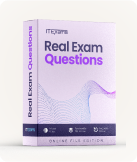Cloudera CCA175 - CCA Spark and Hadoop Developer Exam Exam
Page: 1 / 20
Total 96 questions
Question #1 (Topic: )
Problem Scenario 52 : You have been given below code snippet.
val b = sc.parallelize(List(1,2,3,4,5,6,7,8,2,4,2,1,1,1,1,1))
Operation_xyz
Write a correct code snippet for Operation_xyz which will produce below output.
scalaxollection.Map[lnt,Long] = Map(5 -> 1, 8 -> 1, 3 -> 1, 6 -> 1, 1 -> S, 2 -> 3, 4 -> 2, 7 ->
1)
val b = sc.parallelize(List(1,2,3,4,5,6,7,8,2,4,2,1,1,1,1,1))
Operation_xyz
Write a correct code snippet for Operation_xyz which will produce below output.
scalaxollection.Map[lnt,Long] = Map(5 -> 1, 8 -> 1, 3 -> 1, 6 -> 1, 1 -> S, 2 -> 3, 4 -> 2, 7 ->
1)
Answer: See the explanation for Step by Step Solution and configuration.
Question #2 (Topic: )
Problem Scenario 81 : You have been given MySQL DB with following details. You have
been given following product.csv file
product.csv
productID,productCode,name,quantity,price
1001,PEN,Pen Red,5000,1.23
1002,PEN,Pen Blue,8000,1.25
1003,PEN,Pen Black,2000,1.25
1004,PEC,Pencil 2B,10000,0.48
1005,PEC,Pencil 2H,8000,0.49
1006,PEC,Pencil HB,0,9999.99
Now accomplish following activities.
1. Create a Hive ORC table using SparkSql
2. Load this data in Hive table.
3. Create a Hive parquet table using SparkSQL and load data in it.
been given following product.csv file
product.csv
productID,productCode,name,quantity,price
1001,PEN,Pen Red,5000,1.23
1002,PEN,Pen Blue,8000,1.25
1003,PEN,Pen Black,2000,1.25
1004,PEC,Pencil 2B,10000,0.48
1005,PEC,Pencil 2H,8000,0.49
1006,PEC,Pencil HB,0,9999.99
Now accomplish following activities.
1. Create a Hive ORC table using SparkSql
2. Load this data in Hive table.
3. Create a Hive parquet table using SparkSQL and load data in it.
Answer: See the explanation for Step by Step Solution and configuration.
Question #3 (Topic: )
Problem Scenario 19 : You have been given following mysql database details as well as
other info.
user=retail_dba
password=cloudera
database=retail_db
jdbc URL = jdbc:mysql://quickstart:3306/retail_db
Now accomplish following activities.
1. Import departments table from mysql to hdfs as textfile in departments_text directory.
2. Import departments table from mysql to hdfs as sequncefile in departments_sequence
directory.
3. Import departments table from mysql to hdfs as avro file in departments avro directory.
4. Import departments table from mysql to hdfs as parquet file in departments_parquet
directory.
other info.
user=retail_dba
password=cloudera
database=retail_db
jdbc URL = jdbc:mysql://quickstart:3306/retail_db
Now accomplish following activities.
1. Import departments table from mysql to hdfs as textfile in departments_text directory.
2. Import departments table from mysql to hdfs as sequncefile in departments_sequence
directory.
3. Import departments table from mysql to hdfs as avro file in departments avro directory.
4. Import departments table from mysql to hdfs as parquet file in departments_parquet
directory.
Answer: See the explanation for Step by Step Solution and configuration.
Question #4 (Topic: )
Problem Scenario 58 : You have been given below code snippet.
val a = sc.parallelize(List("dog", "tiger", "lion", "cat", "spider", "eagle"), 2) val b =
a.keyBy(_.length)
operation1
Write a correct code snippet for operationl which will produce desired output, shown below.
Array[(lnt, Seq[String])] = Array((4,ArrayBuffer(lion)), (6,ArrayBuffer(spider)),
(3,ArrayBuffer(dog, cat)), (5,ArrayBuffer(tiger, eagle}}}
val a = sc.parallelize(List("dog", "tiger", "lion", "cat", "spider", "eagle"), 2) val b =
a.keyBy(_.length)
operation1
Write a correct code snippet for operationl which will produce desired output, shown below.
Array[(lnt, Seq[String])] = Array((4,ArrayBuffer(lion)), (6,ArrayBuffer(spider)),
(3,ArrayBuffer(dog, cat)), (5,ArrayBuffer(tiger, eagle}}}
Answer: See the explanation for Step by Step Solution and configuration.
Question #5 (Topic: )
Problem Scenario 53 : You have been given below code snippet.
val a = sc.parallelize(1 to 10, 3)
operation1
b.collect
Output 1
Array[lnt] = Array(2, 4, 6, 8,10)
operation2
Output 2
Array[lnt] = Array(1,2, 3)
Write a correct code snippet for operation1 and operation2 which will produce desired
output, shown above.
val a = sc.parallelize(1 to 10, 3)
operation1
b.collect
Output 1
Array[lnt] = Array(2, 4, 6, 8,10)
operation2
Output 2
Array[lnt] = Array(1,2, 3)
Write a correct code snippet for operation1 and operation2 which will produce desired
output, shown above.
Answer: See the explanation for Step by Step Solution and configuration.
